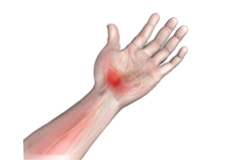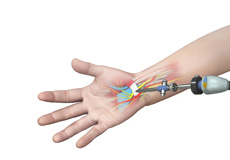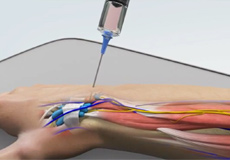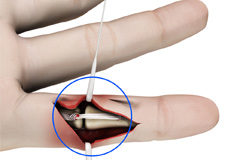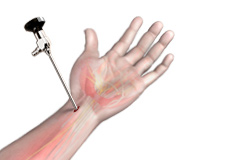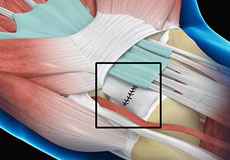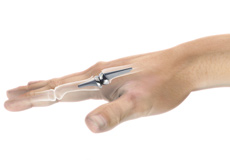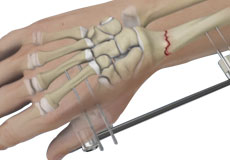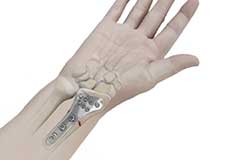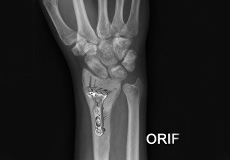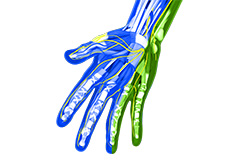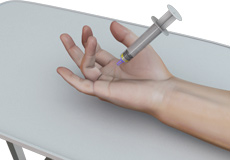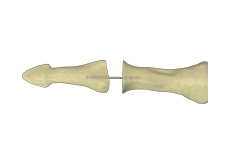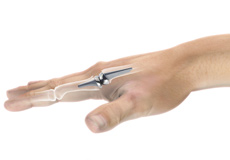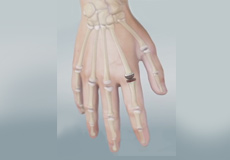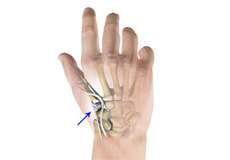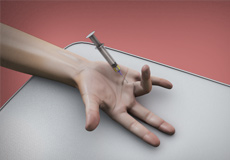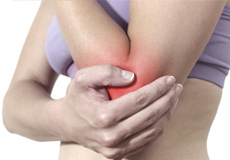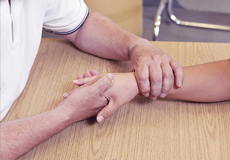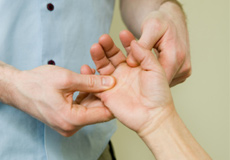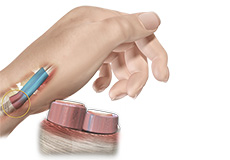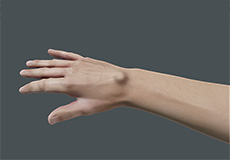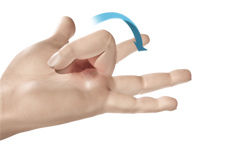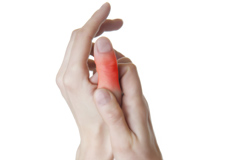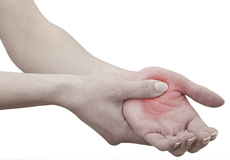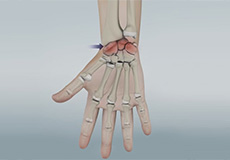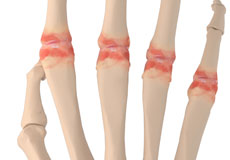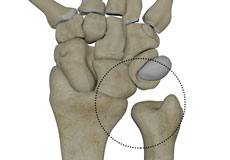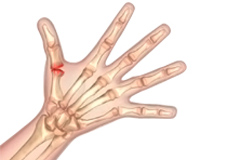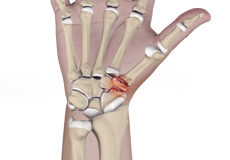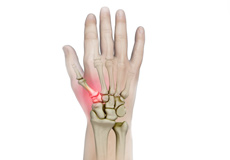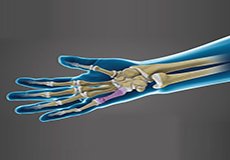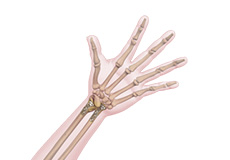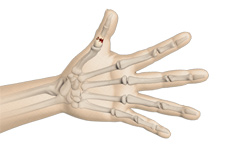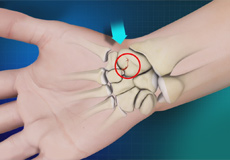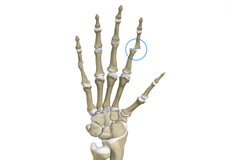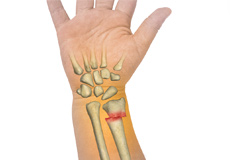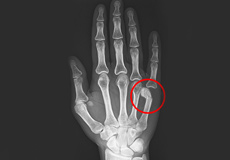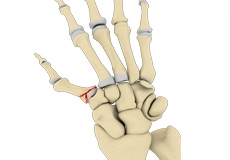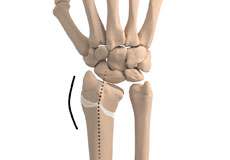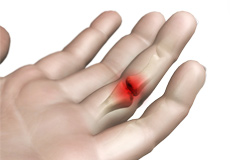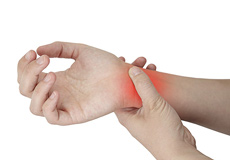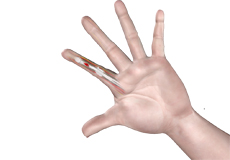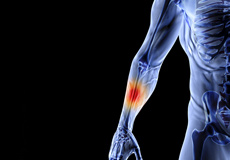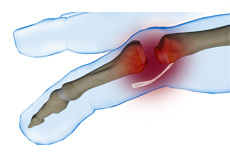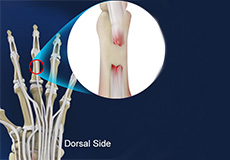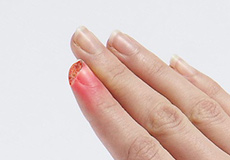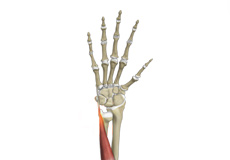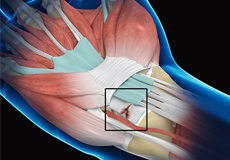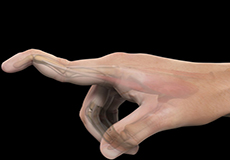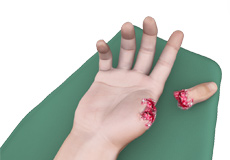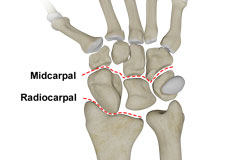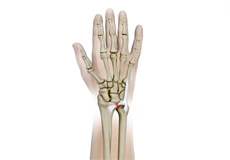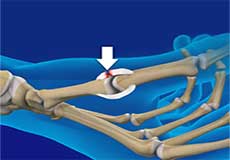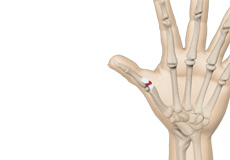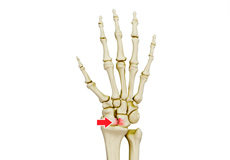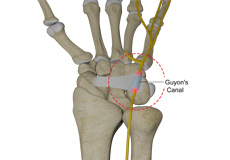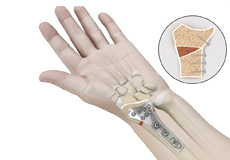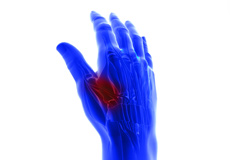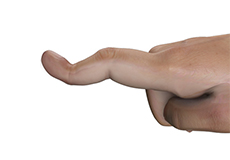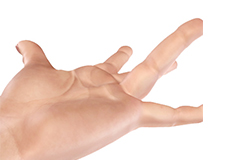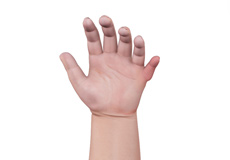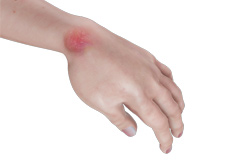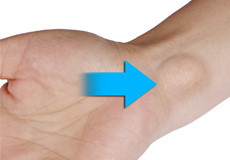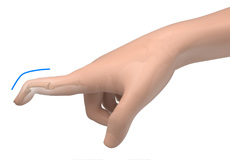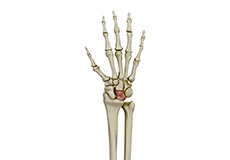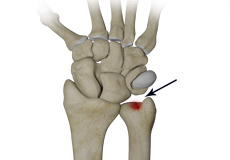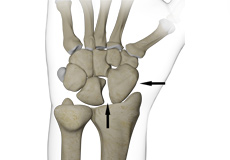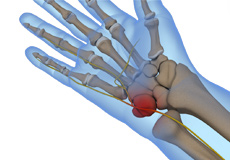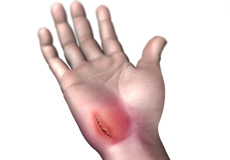-
Carpal Tunnel Release Surgery
Carpal tunnel syndrome is a common, painful, progressive condition that is caused by the compression of the median nerve at the wrist area. Carpal tunnel syndrome can be treated with carpal tunnel release surgery. Traditional surgery involves an incision of up to 2 inches in the palm and wrist area, whereas endoscopic surgery involves one or two half-an-inch incisions and the use of an endoscope.
-
Endoscopic Carpal Tunnel Surgery
The carpal tunnel is a narrow passageway on the palm side of your wrist. Small wrist bones known as carpals form the bottom and sides of the carpal tunnel and a strong band of connecting tissue, known as the transverse carpal ligament, covers the top of the carpal tunnel.
-
Ganglion Cyst Removal
Ganglion cysts are swellings that most commonly develop along the tendons or joints of wrists or hands. They can be found either at the top of the wrist, palm side of the wrist, end joint of a finger or at the base of a finger. A ganglion cyst is not cancerous and will not spread to the other parts of the body. It looks like a water balloon on a stalk and contains a clear fluid or jelly material. Ganglion cysts can be found in people of all ages.
-
Tendon Repair Surgery
Tendon repair surgery is performed to repair a torn or ruptured tendon and restore normal function and movement to the joint. It is usually performed by arthroscopy. An arthroscope is a thin, pencil-like device fitted with a camera and a light source. The arthroscope is inserted through a small incision which allows your surgeon to view images of the torn tendon on a monitor and help operate miniature surgical instruments to perform the surgery.
-
Wrist Arthroscopy
Wrist arthroscopy is a minimally invasive surgical procedure performed to view, diagnose and treat problems of your wrist joint.
-
Wrist Ligament Reconstruction
Ligament reconstruction procedure can be performed as day surgery under local or general anesthesia. During the procedure, your surgeon first makes an incision over your wrist joint to locate the torn ligament. Once located, a tendon graft (tissue obtained from a donor part, usually the palmaris longus tendon of the same wrist) is used to replace the torn ligament.
-
Artificial Finger Joint Replacement
Artificial finger joint replacement is a surgical procedure that involves the removal of an arthritic or damaged finger joint and replacement with an artificial prosthesis.
-
Wrist Fracture Fixation
Wrist fracture fixation may be performed by surgical or non-surgical methods depending on the severity of the fracture.
-
Wrist Open Reduction and Internal Fixation
Open reduction and internal fixation of the wrist is a surgical technique employed for the treatment of severe wrist fractures to restore normal anatomy and improve range of motion and function.
-
ORIF of Distal Radius Fracture
The forearm consists of two bones, the radius and ulna. The radius is the larger of the two forearm bones, and the region towards the wrist is called the distal end. A fracture or break in the distal end of the radius bone is known as a distal radius fracture.
-
Peripheral Nerve Repair
The peripheral nerves are the nerve fibers that compose the area from head to toe, connecting the brain and spinal cord with the rest of the body parts. Nerves transmit electrical impulses and signals to and from the brain. Peripheral nervous system disorders interrupt the transmission of signals and weaken the sensory and motor nerve functions.
-
Hand Fracture Surgery
The hand is one of the most flexible and useful parts of our body. Because of overuse in various activities, the hands are more prone to injuries, such as sprains and strains, fractures and dislocations, lacerations and amputations while operating machinery, bracing against a fall and sports-related injuries.
-
Finger Joint Fusion
Finger joint fusion is a surgical procedure to remove the damaged bony ends of a finger joint followed by insertion of a prosthesis to fuse the bones back together. Finger joint fusion is performed to relieve arthritis pain in the fingers.
-
Surgery for Thumb and Digit Arthritis
Arthritis is an inflammatory condition of the joints. There are several types of arthritis; the most common type is osteoarthritis or wear-and-tear arthritis that affects the joint at the base of the thumb. Thumb arthritis is more common in women than men, and usually occurs after the age of 40 years. Arthritis of the fingers causes swelling, pain, stiffness and malformation, all of which interfere with the use of the hand.
-
Finger Joint Implant
A finger joint implant is an artificial joint made of metal, plastic, or pyrocarbon components that are used to replace a severely arthritic or injured finger joint. Finger implant surgery is a motion-preserving alternative to finger joint fusion surgery.
-
Nerve Decompression of the Upper Extremities
Nerve decompression of the upper extremities, also called peripheral nerve decompression, is a minimally invasive surgical procedure employed to relieve pressure on an entrapped or pinched nerve (neuroma) for the treatment of conditions such as carpal tunnel syndrome and cubital tunnel syndrome, the two most common nerve compression syndromes.
-
CMC Arthroplasty with TightRope
CMC arthroplasty with TightRope, also known as carpometacarpal suspensionplasty, is a novel procedure employed for the treatment of basal joint arthritis (thumb arthritis) found within the trapezium bone of the carpometacarpal (CMC) joint. It addresses the associated narrowing of the joint space, instability, and dislocation.
-
Xiaflex
Xiaflex is an injection consisting of enzymes that are used to break down stiffened tissue. It is used to treat conditions such as Dupuytren’s contracture and Peyronie’s disease.
-
Sports Injury Management of Hand, Wrist and Elbow
Sports injuries are injuries that most commonly occur during sports and exercises. These injuries may result from accidents, poor training practices, and use of improper protective gear, lack of conditioning, and insufficient warm-up and stretching. The sports injuries may be either acute (sprains, fractures, tears) or chronic (tendinitis, overuse injury) injuries.
-
Non-Surgical Treatment of Hand and Wrist
The hand is one of the most flexible and useful parts of our body that enable us to perform many of our daily activities. The hands and wrists are prone to injuries or certain orthopedic conditions and can range from minor cuts or burns to severe arthritis or injuries of nerves, bones, and tendons.
-
Hand Therapy
Hand therapy is a rehabilitation technique recommended to improve the strength and restore functional activity of hands in patients with upper extremity injuries. Hand therapy also helps in preventing injury.
-
De Quervain's Tendinosis
Inflammation and swelling of the tendon sheaths put pressure on the adjacent nerves and leads to pain and numbness in the thumb side of the wrist. Strain on these tendons can cause swelling and irritation, and lead to a condition called De Quervain's tenosynovitis, which is characterized by inflammation. The condition is also referred to as De Quervain’s tendinitis, De Quervain’s tendinosis, De Quervain’s syndrome or De Quervain’s disease.
-
Ganglion Cyst
Ganglion cysts are swellings that most commonly develop along the tendons or joints of wrists or hands. They can be found either at the top of the wrist, palm side of the wrist, end joint of a finger or at the base of a finger. A ganglion cyst is not cancerous and will not spread to the other parts of the body. It looks like a water balloon on a stalk and contains a clear fluid or jelly material. Ganglion cysts can be found in people of all ages.
-
Trigger Finger
Inflammation in the tenosynovium leads to a condition called trigger finger, also known as stenosing tenosynovitis or flexor tendonitis, where one of the fingers or thumb of the hand is caught in a bent position. The affected digit may straighten with a quick snap, like pulling and releasing the trigger on a gun, hence the name trigger finger.
-
Wrist Sprain
Injuries caused due to stretching or tearing of the ligaments in the wrist are called wrist sprains. Sprains can range from mild to severe, based on the extent of injury to the ligament.
-
Finger Sprain
Injuries that involve tearing or stretching of the ligaments of your fingers are termed as sprains. Sprains in the fingers are most often caused from a fall when you extend your arms to reduce the impact of the fall, or from overuse or repetitive activity of the thumb such as with texting.
-
Wrist Pain
Wrist pain is defined as any ache or discomfort in the wrist. The wrist is comprised of two bones in the forearm, the radius and ulna, and eight tiny carpal bones in the palm. The bones meet to form multiple large and small joints. A trauma or injury to one or more of these bones results in wrist pain.
-
Hand Pain
Hand pain is characterized by distress in the joints and tissues of the hand or fingers. Hand pain can be depicted as pulsating, aching, increased warmth, prickling, irritation and inflexibility.
-
Arthritis of the Hand and Wrist
Arthritis is an inflammatory condition of the joints. There are several types of arthritis and the most common type is osteoarthritis or wear-and-tear arthritis. Arthritis affects various joints in the body and the arthritis in the hand affects the joint at the base of the thumb. Arthritis may also affect the joints of other digits.
-
Metacarpophalangeal Joint Arthritis
The bones of the hand are called metacarpals and the bones of the fingers are called phalanges. The metacarpophalangeal joint or MP joint, also known as the first knuckle, is the large joint in the hand where the finger bones meet the hand bones. The MCP joint acts as a hinge joint and is vital during gripping and pinching. When arthritis affects the MP joint, the condition is called MP joint arthritis. The condition is more common in the thumb joint and index finger joint.
-
Distal Radioulnar Joint (DRUJ) Arthritis
Distal radioulnar joint (DRUJ) arthritis is an inflammatory condition characterized by gradual wearing away of the cartilaginous surface of the radioulnar joint resulting in significant pain, swelling, stiffness, and interference in the functioning of the wrist and/or arm.
-
Arthritis of the Thumb
Arthritis is an inflammatory condition of the joints. There are several types of arthritis. The most common type is osteoarthritis or wear-and-tear arthritis that affects the joint at the base of the thumb. Thumb arthritis is more common in women than men, and usually occurs after the age of 40 years.
-
Triscaphoid Joint Arthritis
Arthritis is an inflammatory condition of one or more joints in your body. Triscaphoid joint arthritis is the localised pain and inflammation of the shared joint between the 3 carpal bones of your wrist. These bones are called scaphoid, trapezium, and trapezoid and are present at the base of your thumb.
-
Trapeziometacarpal (TMC) Arthritis
Trapeziometacarapal (TMC) joint arthritis, also known as carpometacarpal (CMC) joint arthritis or basilar thumb arthritis or rhizarthrosis, is a common form of arthritis that affects the first carpometacarpal (trapeziometacarpal) joint of the thumb. It is an inflammatory condition characterized by gradual wearing away of the cartilaginous surface of the TMC joint and the bones rubbing against each other causing inflammation and pain. It occurs most commonly in middle-aged, elderly, and postmenopausal women.
-
Fractures of the Hand and Fingers
A fracture is a break in the bone, which occurs when force greater than the bearable limit is applied against a bone. The most common symptoms of any fracture include severe pain, swelling, bruising or bleeding, deformity and discoloration of the skin and limited mobility of the hand.
-
Wrist Fracture
The wrist is comprised of two bones in the forearm, the radius and ulna, and eight tiny carpal bones in the palm. The bones meet to form multiple large and small joints. A wrist fracture refers to a break in one or more of these bones.
-
Thumb Fracture
A break or a crack in the bones of the thumb is known as a thumb fracture. Fractures may occur anywhere on the thumb, but a fracture at the base of the thumb, near the wrist, is considered the most serious.
-
Scaphoid Fracture
Scaphoid fracture occurs due to a fall on an outstretched hand with complete weight falling on the palm. This fracture usually occurs during motor accidents or sports activities.
-
Finger Dislocation
Finger dislocation is a condition in which the bone of your finger has moved away from its normal position.
-
Forearm Fractures in Children
The radius (bone on the thumb side) and ulna (bone on the little-finger side) are the two bones of the forearm. Forearm fractures can occur near the wrist, near the elbow or in the middle of the forearm. Apart from this, the bones in children are prone to a unique injury known as a growth plate fracture. The growth plate, which is made of cartilage (flexible tissue) is present at the ends of the bones in children and helps in the determination of length and shape of the mature bone.
-
Boxer's Fracture
A boxer’s fracture is a break in the neck of the fifth metacarpal bone of the hand (below the pinky finger) close to the knuckle. The hand is composed of 3 types of bones: carpal or wrist bones, metacarpals or long hand bones, and phalanges or finger bones. Metacarpals consist of five long bones that connect the carpal with the phalanges. Structurally, metacarpal bones can be divided into four parts: base, shaft, neck, and head. In some cases, the broken bone can protrude through the skin and is called an open fracture.
-
Bennett's Fracture
Bennet’s fracture is a break at the base of the first metacarpal bone (thumb bone) that meets the wrist at the first carpometacarpal (CMC) joint. The hand is composed of 3 types of bones: carpals or wrist bones, metacarpals or long hand bones, and phalanges or finger bones. Metacarpals consist of five long bones that connect the carpals with the phalanges. Bennett’s fracture is often displaced and is known as a two-piece fracture.
-
Malunion of a Fracture
Malunion of a fracture is a condition where the fractured ends of a bone heal in a misaligned position resulting in bone deformity. Malunions may occur in any bone fractures in the body often due to trauma.
-
Hand Injuries and Conditions
The hand is made up of the wrist, palm, and fingers and consists of bones, joints, muscles, ligaments, tendons, and many blood vessels and nerves. It is one of the most flexible and useful parts of our body and can suffer injury due to overuse or trauma. The hand can also be affected by certain chronic medical conditions.
-
Wrist Injuries and Conditions
Wrist injuries commonly occur due to falls or certain sports and activities that involve repetitive use or excessive stress or strain on the wrists. These include gymnastics, basketball, working on an assembly line, or typing. Some wrist conditions have no clear cause.
-
Flexor Tendon Injuries
Deep cuts on the under surface of the wrist, hand or fingers can cut and injure the tendon, and make it unable to bend one or more joints in a finger. When a tendon gets cut, the cut ends gets pulled away from each other like a rubber band.
-
Wrist Injuries
The wrist is a commonly injured joint in the body. Problems include sprains and strains as well as fractures that can occur with lifting and carrying heavy objects, while operating machinery, bracing against a fall, or from sports-related injuries.
-
Work Related Hand Injuries
The hand is one of the most flexible and useful parts of our body that assist us in most workplace activities. Hand injuries can range from minor cuts or burns to severe injuries.
-
Finger Joint Dislocation and Volar Plate Injury
Finger dislocation is a condition where the bones of your finger have moved away from its normal anatomical position.
-
Extensor Tendon Injuries
Tendons are bands of tissue connecting muscles to bones. The extensor tendon is a strong, smooth cord that connects finger bones to muscles in the hand. Extensor tendons are located just under the skin, directly on the bone, on the back of the hand and fingers. They allow you to open your hands and move or straighten your wrist, fingers, and thumb.
-
Fingertip Injuries
A fingertip injury is a wound or damage caused to the most distal portion of the finger. It can be a crush, a sharp cut, a tear or a combination of these, and can result in damage to the skin, nail or nailbed, tendon, pulp, bone, and nerve endings. It is one of the most common injuries to the hand and may occur due to accidents at home, work, or play.
-
Distal Radioulnar Joint (DRUJ) Instability
Distal radioulnar joint instability is the abnormal orientation or movement of the radius and ulna bones at the wrist in relation to one another. Injury to the tendons, ligaments and/or muscles stabilizing the joint may cause partial or complete dislocation.
-
Extensor Carpi Ulnaris (ECU) Tendon Instability
ECU tendon instability can occur when the sheath covering and protecting the ECU tendon at the wrist is injured. This causes the tendon to move abnormally and occupy the wrong space within the sheath.
-
Wrist Ligament Tear and Instability
A ligament is a strong, flexible band of fibrous tissue. The wrist has many ligaments that help to keep the wrist bones in proper position providing stability to the joint. A torn ligament causes the wrist bones to move out of their position, which in turn leads to wrist instability as the sprained (torn) ligament can no longer support the wrist bones.
-
Mallet Finger
A mallet finger is a condition where the end of the finger is bent and does not straighten. Mallet finger occurs when the extensor tendon at the back of the finger is damaged.
-
Industrial Hand Trauma
The hand is one of the most flexible and useful parts of our body. Because of overuse in various activities, the hands are more prone to injuries, such as sprains and strains, fractures and dislocations, lacerations and amputations while operating machinery, bracing against a fall and during sports. Workplace or industrial hand trauma is the leading cause of lost workplace work hours and visits to the emergency room. Industrial hand injuries can be minor to life-threatening.
-
Carpal Instability
Carpal instability is the loss of alignment of the carpal bones and/or radioulnar joint. The wrist is a complex joint that connects the forearm to the hand and allows it to move. It consists of 8 small bones called carpals that articulate with two long bones of the forearm (radius and ulna). The joint is supported by ligaments, tendons, nerves, blood vessels and muscles that help in movement.
-
Triangular Fibrocartilage Complex Injury (TFCC)
The triangular fibrocartilage complex, or TFCC, is a complex of cartilage and ligaments located near the outer region of the wrist, below the little finger. It serves to stabilize the wrist, allowing easy movement and shock-absorption. Sports activities or falls can damage or injure the TFCC, causing wrist pain and instability. The injured TFCC may also produce a clicking sound with certain wrist movements.
-
Gamekeeper's Thumb
Gamekeeper's thumb, also known as skier's thumb, is a tear of the ulnar collateral ligament, a band of tissue that supports the joint at the base of the thumb.
-
Skier's Thumb
Skier's thumb, also known as, Gamekeeper's thumb is a tear of the ulnar collateral ligament, a band of tissue that supports the joint at the base of the thumb. Damage to the ulnar collateral ligament may lead to chronic instability of the thumb, creating problems in its normal functioning.
-
Carpal Tunnel Syndrome
Carpal tunnel syndrome is a common, painful, progressive condition that is caused by compression of the median nerve at the wrist area.
-
Scapholunate Advanced Collapse (SLAC) Wrist
Scapholunate advanced collapse (SLAC) wrist is the most common form of degenerative arthritis of the wrist that occurs secondary to traumatic injury of the scapholunate ligament with subsequent collapse on the radial side of the wrist. SLAC wrist is a complication that results due to an undiagnosed or untreated scapholunate interosseous ligament (SLIL) injury, which can often be misdiagnosed as “wrist sprain.”
-
Ulnar Nerve Compression in Guyon's Canal
Ulnar nerve compression in Guyon’s canal is a condition characterized by pain, numbness, weakness, and tingling sensation in the hand. The condition occurs when the ulnar nerve, the nerve that travels across the elbow from the shoulder to the hand, is compressed as it goes from the wrist into the hand through a space known as Guyon’s canal. Ulnar nerve damage stops or slows down signals that are being sent across the nerve to the hand.
-
Distal Radius Osteotomy to Correct Mal-Union (Crooked Painful Wrist)
The forearm consists of two bones, the radius, and the ulna. The radius is the larger of the two forearm bones, and the region closest to the wrist is called the distal end. A fracture or break in the distal end of the radius bone is known as a distal radius fracture.
-
Distal Intersection Syndrome
Distal intersection syndrome also referred to as tenosynovitis of the radial wrist extensors is characterized by the radial wrist and forearm pain. Distal intersection syndrome is tenosynovitis of the third extensor compartment (extensor pollicis longus) where it crosses the second extensor compartment.
-
Boutonniere Deformity
Tendons in your fingers connect the finger bones to finger muscles and help bend and straighten the finger at the joint when the muscles contract. Boutonnière deformity is a condition in which a tendon injury to the middle joint of the finger results in the inability to straighten the affected finger.
-
Dupuytren's Contracture
Dupuytren’s contracture is a hand condition where thickening of the underlying fibrous tissues of the palm causes the fingers to bend inward. This makes it difficult to fully straighten the affected fingers. It commonly occurs in the ring finger and little finger. Occasionally, the middle finger is affected, but the thumb and index finger are rarely affected.
-
Congenital Defects of the Hand and Wrist
The hand and wrist are formed during the 8th week of gestation. This process consists of various steps and failure in any one or more of these steps may cause congenital or birth defects. The deformities may be major (absence of a bone) or minor (disproportion of a finger).
-
Hand Infections
Hand infections, if left untreated or treated improperly, can cause disabilities such as stiffness, contracture, weakness, and loss of tissues (skin, nerve and bone) that will persist even after the infection resolves. Therefore, prompt treatment of hand infections is important.
-
Wrist Tumors
A tumor is a lump or abnormal growth formed due to unregulated cell division. Wrist tumors can occur on or underneath the skin. They are most often benign (non-cancerous).
-
Swan Neck Deformity
The finger joint is a hinge joint that allows the bending and straightening of the fingers. Each finger is composed of 3 phalange bones joined by 2 interphalangeal joints (IP joints). The joint near the base of the finger is called the proximal IP joint (PIP joint), and the joint near the tip of the finger is called the distal IP joint (DIP joint).
-
Kienbock's Disease
Kienbock's disease is a condition in which the lunate, one of the small bones of the wrist loses its blood supply leading to death of the bone. This results in pain, stiffness, and degenerative changes in the wrist joint.
-
Ulnar Carpal Impaction
The wrist is a complex joint made up of 8 carpal bones aligned in two rows, with four bones present in each row. The carpal bones are further connected to 5 metacarpal bones that form the palm of the hand. Each small bone forms a joint with the bone next to it. Thus, the wrist joint is made up of many small joints. The two bones of the forearm, radius, and ulna, also form a joint with the first row of carpals.
-
Scapholunate Advanced Collapse (SLAC): Wrist Osteoarthritis
Scapholunate advanced collapse of the wrist or SLAC is the most common pattern of degenerative osteoarthritis of the wrist.
-
Guyon's Canal Syndrome
Guyon’s canal syndrome refers to compression of the ulnar nerve while it passes from the wrist into the hand through a space called the ulnar tunnel or Guyon’s canal.
-
Hand Tumors
Any abnormal lump or bump on the hand is considered a hand tumor. Hand tumors can occur on the skin as a mole or a wart, underneath the skin soft tissue or on the bone. Most hand tumors are benign (non-cancerous); however, they can also rarely be malignant (cancerous).
The human hand is made up of the wrist, palm, and fingers and consists of 27 bones, 27 joints, 34 muscles, over 100 ligaments and tendons, and many blood vessels and nerves.
The hands enable us to perform many of our daily activities such as driving, writing and cooking. It is important to understand the normal anatomy of the hand to learn more about diseases and conditions that can affect our hands.
Bones of the Hand
The wrist is comprised of 8 carpal bones. These wrist bones are attached to the radius and ulna of the forearm to form the wrist joint. They connect to 5 metacarpal bones that form the palm of the hand. Each metacarpal bone connects to one finger at a joint called the metacarpophalangeal joint (MCP joint). This joint is commonly referred to as the knuckle joint.
The bones in our fingers and thumb are called phalanges. Each finger has 3 phalanges separated by two interphalangeal joints, except for the thumb, which has only 2 phalanges and one interphalangeal joint.
The first joint close to the knuckle joint is called the proximal interphalangeal joint (PIP joint). The joint closest to the end of the finger is called the distal interphalangeal joint (DIP joint).
The MCP and PIP joint act like hinges when the fingers bend and straighten.
Soft Tissues of the Hand
Our hand bones are held in place and supported by various soft tissues. These include: articular cartilage, ligaments, muscles and tendons.
Articular cartilages are smooth material that act as shock absorbers and cushion the ends of bones at each of the 27 joints, allowing smooth movement of the hand.
Muscles and ligaments function to control the movement of the hand.
Ligaments are tough rope-like tissues that connect bones to other bones, holding them in place and providing stability to the joints. Each finger joint has two collateral ligaments on either side, which prevents the abnormal sideways bending of the joints. The volar plate is the strongest ligament in the hand. It joins the proximal and middle phalanx on the palm side of the joint and prevents backward bending of the PIP joint (hyperextension).
Muscles of the Hand
Muscles are fibrous tissues that help produce movement. They work by contracting.
There are two types of muscles in the hand:
- Intrinsic muscles are small muscles that originate in the wrist and hand. They are responsible for fine motor movements of the fingers during activities such as writing or playing the piano.
- Extrinsic muscles that originate in the forearm or elbow control the movement of the wrist and hand. These muscles are responsible for gross hand movements. They position the wrist and hand while the fingers perform fine motor movements.
Each finger has six muscles controlling its movement: three extrinsic and three intrinsic muscles. The index and little finger each have an extra extrinsic extensor.
Tendons of the Hand
Tendons are soft tissues that connect muscles to bones. When muscles contract, tendons pull the bones, causing the finger to move. The extrinsic muscles are attached to finger bones through long tendons that extend from the forearm through the wrist. Tendons located on the palm side help in bending the fingers and are called flexor tendons, while tendons on top of the hand called extensor tendons help in straightening the fingers.
Nerves of the Hand
Nerves of the hand carry electrical signals from the brain to the muscles in the forearm and hand, enabling movement. They also carry the senses of touch, pain and temperature back from the hands to the brain.
The three main nerves of the hand and wrist include:
- Ulnar nerve: The ulnar nerve crosses the wrist through an area called Guyon’s canal and branches to provide sensation to the little finger and half of the ring finger.
- Median nerve: The median nerve crosses the wrist through a tunnel called the carpal tunnel. The median nerve provides sensation to the palm, thumb, index finger, middle finger and part of the ring finger.
- Radial nerve: The radial nerve runs down the thumb side of the forearm and provides sensation to the back of the hand from the thumb to the middle finger.
All three nerves originate at the shoulder and travel down the arm to the hand. Each of these nerves has sensory and motor components.
Blood Vessels of the Hand
Blood vessels travel beside the nerves to supply blood to the hand. The main arteries are the ulnar and radial arteries, which supply blood to the front of the hand, fingers, and thumb. The ulnar artery travels next to the ulnar nerve through the Guyon’s canal in the wrist. The radial artery is the largest artery of the hand, traveling across the front of the wrist, near the thumb. Pulse is measured at the radial artery.
Other blood vessels travel across the back of the wrist to supply blood to the back of the hand, fingers and thumb.
Bursae of the Hand
Bursae are small fluid-filled sacs that decrease friction between tendons and bone or skin. They contain special cells called synovial cells that secrete a lubricating fluid.


